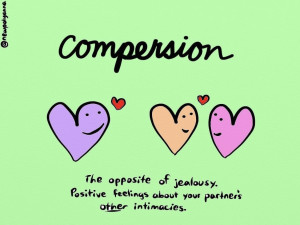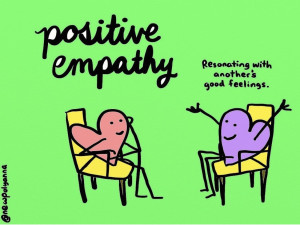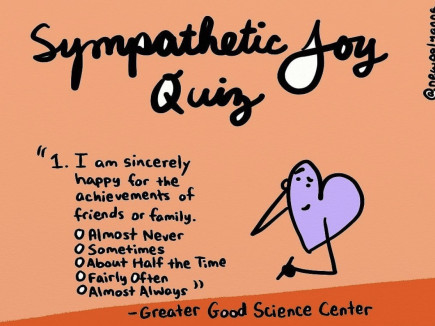When someone you care about experiences a positive event—like a work promotion, a graduation, a new romance—it is considered not only normal, but emotionally healthy, to rejoice in their success.
There is ONE glaring exception to this convention: If our romantic partner experiences pleasure from an intimate relationship with somebody else, the social expectation is invariably for feelings of jealousy and betrayal to take center stage.
This expectation is a central feature of mononormativity—the cultural norm that frames monogamy (or, at least, serial monogamy) as the only respectable way to form and maintain intimate bonds. This norm rests on the very assumption that jealousy is the only valid reaction to a romantic partner developing an intimate relationship with someone outside the couple.
What if this assumption weren’t accurate? What if some of us experienced delight and other positive feelings in regard to our partner’s other intimate connections—whether instead of, or in addition to, jealousy? This intriguing possibility, referred to as “compersion,” led me to empirically research this little-known phenomenon.
Compersion is related to “sympathetic joy,” which is our wholehearted participation in the happiness of others. It includes the positive thoughts, emotions, and sensations derived from knowing of another person’s gratifying experience, even when this experience does not involve or benefit us directly. In that sense, compersion is the direct antonym of jealousy—although, that said, it is certainly not necessary (or realistic) to “get rid” of jealousy before we can experience sympathetic joy generally and compersion specifically. It is common, and entirely natural, to experience both jealousy and compersion at the same time.
While my research focuses on polyamorous people—those who engage in multiple, simultaneous relationships with the knowledge and consent of all involved—there are lessons from this work for monogamous couples experiencing any kind of envy and jealousy. Indeed, it holds relevance for anyone who wants more love and empathy in their lives.
The psychology of sympathetic joy
The term “compersion” was coined in the early 1990s by the Kerista community, a San Francisco-based polyamorous group that has since disbanded. Although nonmonogamists were the first to add this term to the English language, the concept itself wasn’t new.
Buddhists have long considered sympathetic joy (referred to as muditā in Sanskrit) to be one of the “four immeasurable states” (brahmavihārās) or qualities of the enlightened person—the other three being loving-kindness (mettā), compassion (karunā), and equanimity (upekshā). According to this tradition, muditā remedies the illusory separateness between self and others and can therefore be a powerful vehicle on the path to liberation.
In its original context, Buddhist practitioners first practiced sympathetic joy toward friends or loved ones, then directed it to people toward whom they felt neutral, and finally in relation to difficult or hostile people, until the practice would encompass all beings.
Most spiritual traditions, in fact, suggest that transforming subtle forms of self-centeredness and egotism into altruism and generosity is a critical part of spiritual progress. For example, in Christianity, the practice of agape (or selfless love) includes desiring the well-being and happiness of all human beings. In Sufism, opening the “eye of the heart” is said to allow one to see the divine mystery everywhere and thus rejoice in the presence of anyone’s happiness.
The fact that sexual and romantic realms are omitted from those teachings, Jorge Ferrer explains in a 2007 paper, is probably because “[g]enetic selfishness is so archaic, pandemic, and deeply seated in human nature that it invariably goes unnoticed in contemporary culture and spiritual circles.”
Indeed, jealousy is considered an adaptive response, having emerged around 3.5 million years ago in hominid ancestors as a vital evolutionary mechanism—and thus a deeply ingrained, often subconscious, emotional habit.
In spite of this challenge, there are many avenues that may explain the reality of compersion. My research suggests that it may have roots in both reciprocal altruism—the biological equivalent of the “tit for tat” strategy used in game theory—and kin altruism—a flavor of altruism that is based on empathy rather than a purely egoistical reciprocity.
In fact, it appears the two mechanisms may be feeding one another. The idea that kin and reciprocal altruism can be reconciled through the concept of empathy was suggested by evolutionary scientist Martin Hoffman, who argued that “empathy may be uniquely well suited for bridging the gap between egoism and altruism.”
According to Hoffman as well as primatologist Frans de Waal, the question as to whether “true” altruism is devoid of selfish reward may be a false dichotomy because “empathic engagement hooks one into the other’s situation. . . [and] gives individuals an emotional stake in the welfare of others.”
Compersion is a part of an alternative conception of love that is built on abundance and collaboration, rather than possession and territoriality. As psychologist David Boone speculated in a 2009 paper:
If jealousy has been “programmed” into the human psyche due to past adaptational challenges and evolutionary needs, then does the much more recent advent and intentional cultivation of an opposite emotion— compersion—represent a mere outlier of an anomalous counter-evolutionary current? Or rather, does it show evidence for an emerging change in trajectory for human social and relational evolution? I would argue for the latter, because as we look at the specific cultural and environmental differences between the times of our ancestors and our own time, it is clear that the adaptational challenges for survival and reproduction that we face now are very different from those of millions of years ago.
It’s this possibility of social transformation that led me to study compersion. My 2021 doctoral research on compersion utilized qualitative research methods, which means I interviewed a small pool of participants in depth, rather than giving standardized surveys to a large number of folks. This style of research is particularly suited when a topic is still underresearched, because the rich qualitative data helps establish foundational definitions and theories for future studies to build upon.
I initially interviewed 17 nonmonogamous participants ranging from 25 to 83 years old (some of them had been nonmonogamous for over four decades!) about their experiences of compersion—what it feels like, what promotes it, what hinders it, and how they believe empathic joy might be connected to social change.
This year, I participated in further qualitative research with two colleagues on the same themes, with a new pool of 44 participants and a written questionnaire. Our results were remarkably consistent with my previous study.
Where does compersion come from?
Overall, our study participants described compersion as a state of deep interconnectedness, where a benefit to a partner was perceived as a benefit to oneself, thus inducing a feedback loop of positive emotions.
These reports are congruent with several modern psychological theories that may explain the underpinnings of compersion and the pathways through which the experience might strengthen and deepen relationships.
The broaden-and-build theory suggests that positive emotions bring people closer together, bringing them to perceive others in kin-like ways. It postulates that positive emotion broadens people’s sense of self, resulting in greater self-other overlap and feelings of “oneness” with others. Self-other overlap is thought to create a more complex understanding of others, which may be the key to more fully understanding their partner’s perspective, opening up the possibility of experiencing joy (that is, compersion) from a relationship that does not include them.
The connection between positive emotions and self-other overlap is also congruent with self-expansion theory, which suggests that as people form close relationships, they begin to perceive the other as part of the self. The theory also argues that, not only are positive emotions created by experiences that expand the self, but that positive emotions can induce self-expansion.
In that case, positive feelings toward one’s partner can increase self-other overlap, facilitating the experience of compersion. At the same time, the positive feelings of compersion may contribute to an increasing sense of overlap between the self and partner. This cyclical process may result in increasing positive feelings over time as well as a stronger sense of self-other overlap with one’s partner, both of which are related to relationship satisfaction.
Another theory that may increase our understanding of compersion is crossover theory, which focuses on the emotional influence that intimate partners have on each other. The theory suggests that the experiences of one partner can affect the well-being of the other partner, for better or for worse.
Finally, several study participants referenced mindfulness, in which individuals strive to maintain a curious, open, and accepting awareness of their experience in the current moment, as key to enabling their feelings of compersion. Although mindfulness has been typically conceptualized at the individual level, the interpersonal benefits have been receiving increasing attention. Mindfulness is thought to promote empathy for others while simultaneously fostering distress tolerance. As articulated by one participant who explained that listening to truly understand their partner’s experience gave rise to feelings of compersion, empathy is thought to stem from centering one’s awareness on another person’s needs and emotion.
In Buddhism, the practice of muditā entails the meditative repetition of phrases such as “I am happy that you are happy,” “May your happiness and good fortune not leave you,” or “May your happiness not diminish.” Similarly, we could hypothesize that mindfulness-based techniques such as loving-kindness meditation may increase feelings of compersion.
How a strong self promotes compersion
The factors that my colleagues and I found to promote and hinder compersion could be considered a relational roadmap to fulfilling relationships—a lot of which can be applied to monogamous partnerships.
First, we discovered that individual factors—such as mindset, self-esteem, self-care, and self-confidence—were precursors to folks feeling supportive of their partner’s other relationships. At the cognitive level, participants who were fully “on board” with nonmonogamous values and mindsets would have better chances to develop compersion, because they were ideologically committed to honoring their partner’s sexual and romantic autonomy—a value that is mutually exclusive with the belief that jealousy entitles us to controlling our partner’s intimate behaviors.
In other words, these people were committed to taking responsibility for their own jealousy rather than asking others to accommodate it as a response. To do so, they would proactively use strategies to both conceptualize and manage jealousy in ways that would reduce its potential harm on the relationship.
One of the main strategies used was to differentiate and disconnect the source of jealousy from the event. Jealousy was understood to derive from one’s own insecurities or monogamous socialization, as opposed to the presence of another lover. As such, participants interpreted jealous experiences as emotions that could be tolerated or transformed, rather than a reason not to share their lover(s). In other words, all the participants believed that they could master jealousy to whatever level was necessary to make it worth being nonmonogamous. They also believed that jealousy was not inevitable, nor inflexible.
Often, working with jealousy also meant strategizing with their partners to minimize specific jealousy triggers, ask for reassurance when needed, and maintain relationship boundaries that would minimize the occurrence of jealousy. For several participants, it meant doing a lot of introspection to understand where their jealousy was coming from, and then learning to self-soothe and heal their main jealousy triggers.
A sense of security within oneself was key to being successful in this realm. If someone felt that their needs were met and their “plate was full” in terms of work, friendships, family relationships, physical and emotional health, etc., they would be much more likely to feel compersion when their partner(s) would intimately connect with others.
A sense of being grounded in one’s autonomy, as opposed to rooting one’s sense of identity and security in a romantic relationship, was equally crucial to participants’ ability to experience compersion. Respect for one’s own personal autonomy and agency was foundational to respecting other people’s autonomy and agency, which led participants to form relationships based on emotional resilience. Conversely, individuals who lacked autonomy—whether psychological, emotional, or financial—would tend to embark on fusional or codependent relationships where connections with others would be met with fear and jealousy rather than compersion.
How strong relationships make more compersion
The other main category of factors that promoted compersion were relational ones. These included trust, communication, and security within the relationship. The more connected the relationship, the more likely participants were to experience compersion for their partner(s).
This was related to a sense of feeling included in, rather than left out from, one’s partner’s experience of other relationships. Jealousy often stems from a sense of being emotionally excluded from an exciting event or experience. Conversely, compersion is based on empathic joy: At its core, the principle of compersion relies on the dissolution of the perception of separation between self and other.
Thus, compersion requires a positive integration of other experiences within the relationship dynamic. That is not to say that lovers wanted to be physically present on their partner’s dates or know every detail of their connection to others—but there had to be sufficient emotional connectedness, along with the absence of secretiveness or betrayal, for compersion to flourish.
Research participants also mentioned that receiving benefits from their partner’s other relationships laid a fertile ground for compersion. Folks I interviewed often expressed gratitude for the fact that their nonmonogamous lifestyles afforded them richer emotional, sexual, and social lives by bringing a wider diversity of people and experiences into the picture. In addition, they emphasized the ability to be more emotionally authentic and live in congruence with their values around sexual autonomy and agency.
Many people also mentioned the relief they felt from the pressure to fulfill all of their partner’s needs in a mononormative setting. For example, a man in his 50s who did not enjoy dancing was delighted that his wife’s new boyfriend was an avid dancer—and therefore was relieving him from the guilt of not granting this pleasure to his wife himself!
How does this apply to monogamy?
In my coaching practice, I often witness monogamous couples experiencing envy and jealousy in the absence of objective threats of infidelity.
For example, one might feel that their partner spends excessive energy at work or with their friends, and insufficient time cultivating their intimate relationship. At times, they might also feel uncomfortable around the depth of connection their partner is having with another, even when such a connection is strictly platonic. They may struggle to feel happy for their partner in these areas because they feel neglected, left out, or simply too underresourced to feel generous or empathetic.
The solution here is NOT to shun jealousy or envy, according to my work. Instead, we can take advantage of those emotions and use them as powerful flashlights to illuminate the places where our needs—especially those related to individual and relational safety—aren’t met, and to learn how to better meet them.
For example, if my partner is enjoying a connection with a new friend and I find myself feeling uncomfortable, this might be an opportunity to look at what exactly is causing my discomfort. Am I envious that I don’t have as much friendship in my life? If so, how can I create more of that? Am I feeling excluded from my partner’s experience in some way? If so, can I enhance my communication with them so I may share in their enjoyment and feel connected to them?
A disclaimer: In some cases, a relationship might simply not be healthy enough, or meet enough of your needs, to be worth staying in. Your partner may, in fact, be intentionally pushing you away. In these cases, it could be best to invest your energy into relationships where mutual care, vision, and investment are present. In other words, the practice of compersion should not be confused with self-abuse or putting up with toxic dynamics!
That said, when we are part of a healthy, intimate connection, inviting a compersive mindset can help us feel like a team. As a team, “more for you is more for me.” Otherwise, we easily slip into an individualistic, zero-sum mindset, where “more for you is less for me.” It is also helpful to look at the world through our partners’ eyes. Tuning into them more deeply may promote empathy, which in turn paves the way to compersion.
Looking at love as a way to elevate one another, and taking joy in their autonomous, unique, and incommensurable expression—rather than under the lens of conditionality and control—begins with an intention. When we develop a “compersive attitude,” experiences of envy or jealousy can be framed not as a personal affront, but as an indicator that there is an opportunity to fill our individual and relational plates more abundantly.
The bottom line, for monogamous and nonmonogamous people alike, is to try to cultivate our own garden, and remember that another person’s success is ultimately a win for the collective. Noticing the places where this is particularly difficult to do can help us identify the bottlenecks where there is room for us to grow, heal, connect, and love more.
 ©
© 


 ©
© 







Comments